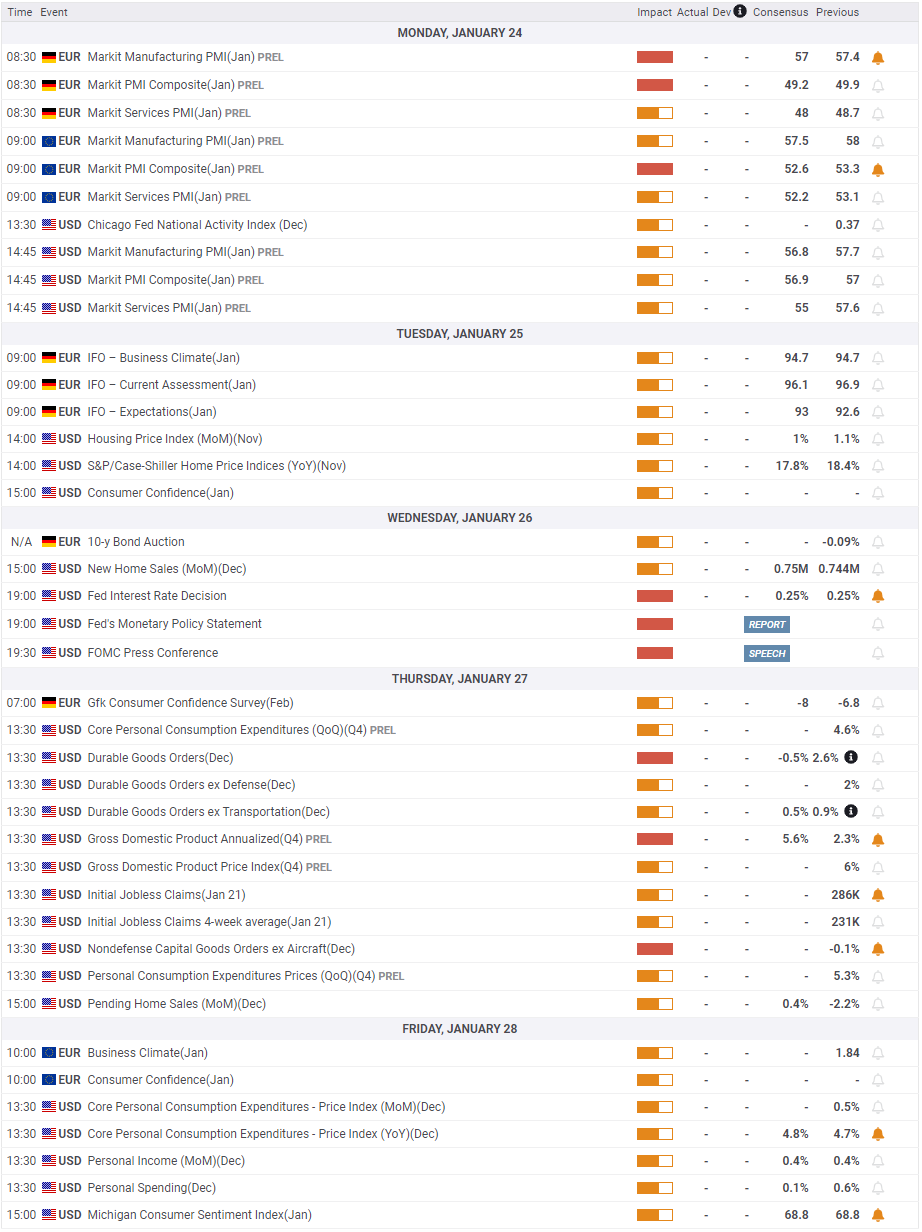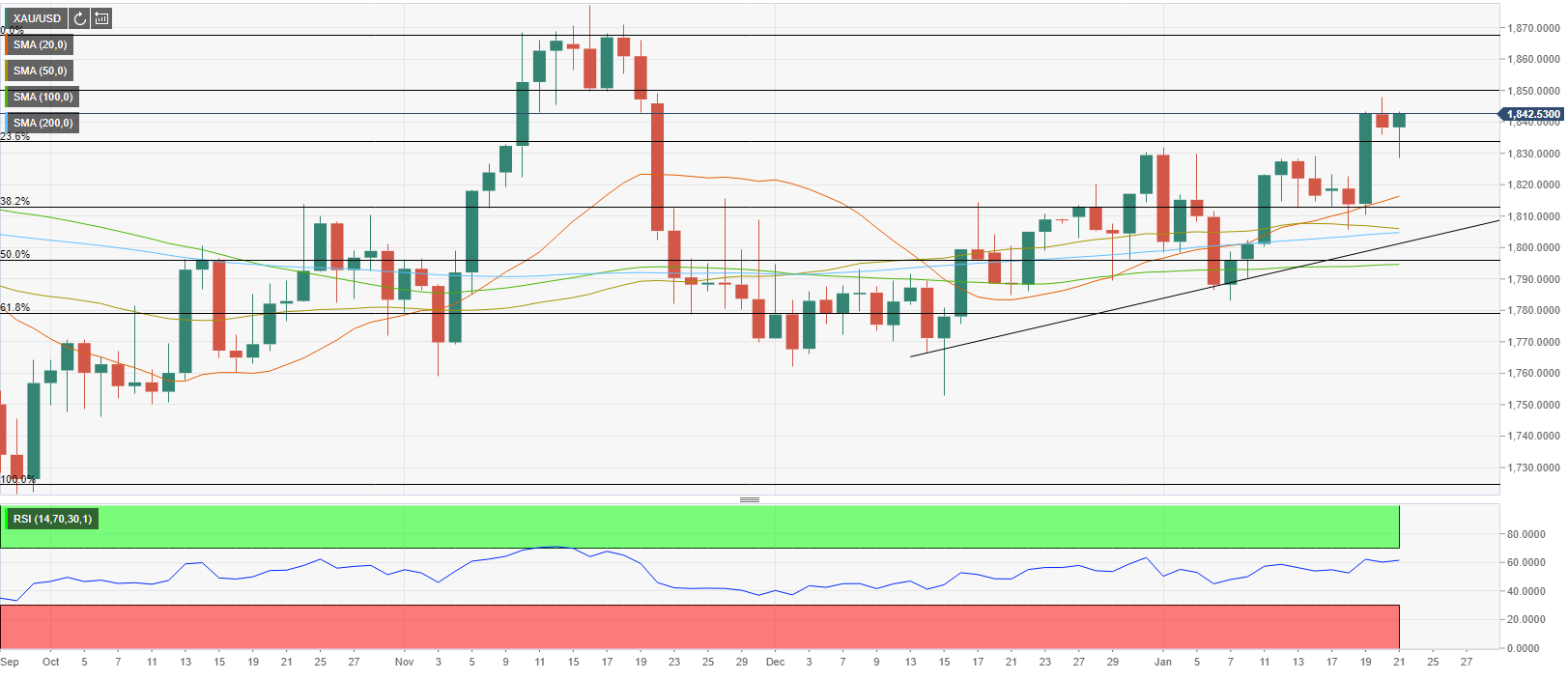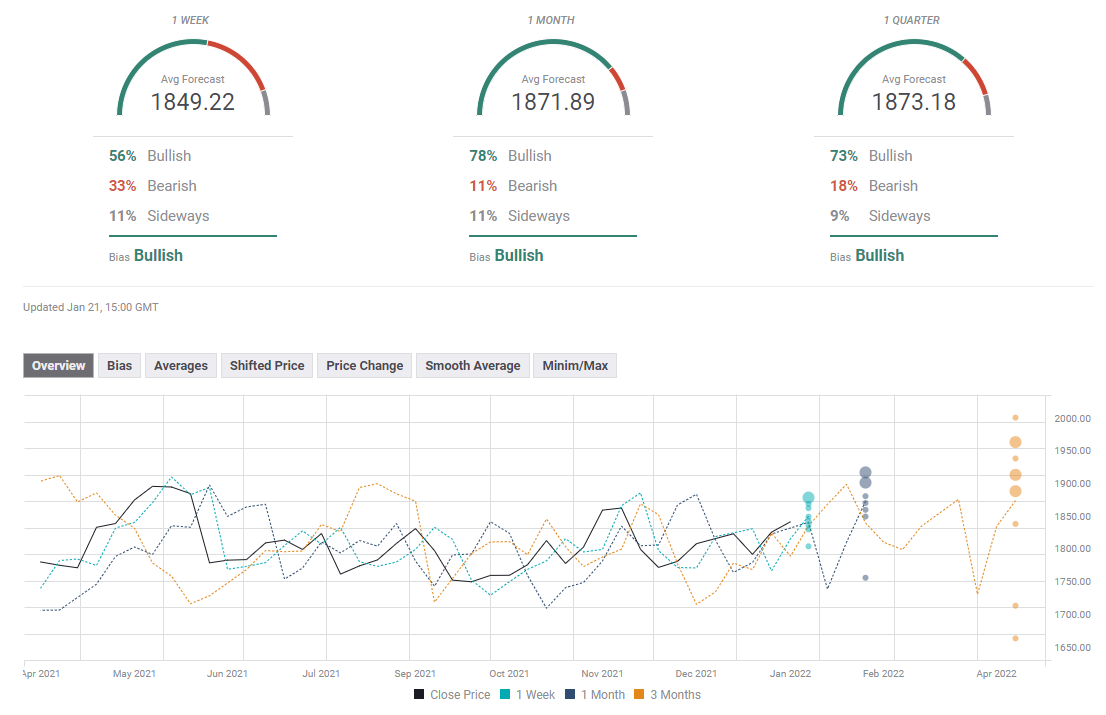- Gold registered its highest weekly close since mid-November.
- Sharp decline witnessed in US T-bond yields and technical breakout boosted XAU/USD.
- Focus shifts to high-tier US data releases and FOMC's policy meeting.
After a tarnished start to the week, gold made impressive gains, breaking above a key resistance area on Wednesday and reaching its highest level in nearly two months, near $1,850, on Thursday. From there, the yellow metal went into consolidation mode, giving back some of its weekly gains, but ended up closing the second straight week in positive territory.
What happened last week
The market chatter about the US Federal Reserve considering a 50 basis points rate hike in March increased in volume in the first half of the week and provided a boost to US Treasury bond yields. The benchmark 10-year US T-bond yield rose more than 5% and reached its highest level in two years at 1.9% early Wednesday.
Fed Governor Christopher Waller said that he wouldn’t favour a 50 bps hike in March, just before the Fed’s blackout period started on Saturday, January 15. Nevertheless, this comment caused investors to speculate that this was on the table as an option. Additionally, billionaire investor Bill Ackman argued that the Fed would need to go for a 50 bps hike to restore its credibility. Finally, Anna Wong, Chief US Economist for Bloomberg Economics, said that their in-house model of a Fed reaction function was suggesting that a 50 bps rate increase in March was warranted.
In the second half of the week, safe-haven flows started to dominate the financial markets and the sharp retreat witnessed in the US T-bond yields fueled a gold rally.
The ongoing conflict between Russia and Ukraine, the People’s Bank of China’s efforts to loosen their policy amid worsening economic outlook and the steep drop seen in Wall Street forced investors to seek refuge. Data published by the US Department of Labor showed on Thursday that there were 286,000 initial claims - the highest reading since October - for unemployment benefits in the US last week, further weighing on sentiment.
XAU/USD rose nearly 2% from Tuesday’s closing level and touched its strongest level since November 22 at $1,849 late Thursday. The 10-year US T-bond yield erased all of its weekly gains and returned below 1.8% on Friday.
Next week
On Wednesday, the Fed will announce its policy rate decision and release the Monetary Policy Statement following its two-day meeting.
Dovish scenario: The Fed adopts a dovish tone by suggesting that it will remain patient with regards to policy tightening. US T-bond yields could fall sharply on such a shift in the policy outlook and provide a boost to XAU/USD. FOMC Chairman Jerome Powell would need to voice renewed concerns over the labour market and the growth outlook to convince investors that they will not rush to continue to lift rates after March. According to the CME Group’s FedWath Tool, there is only a 10% probability of the Fed leaving its policy rate unchanged in March.
Hawkish scenario: Chairman Powell will definitely have to respond to questions on the possibility of a 50 bps hike in March. If Powell reveals that they have discussed such an option, US T-bond yields could surge higher and force gold to turn south. Moreover, a decision to increase the reductions in monthly asset purchases could also be assessed as a bullish development for the greenback.
The most likely scenario is that the Fed leaves its policy settings unchanged and reiterates that policymakers will continue to monitor economic developments closely. In that case, Friday’s Personal Consumption Expenditures (PCE) Price Index data, the Fed’s preferred gauge of inflation, could trigger a significant market reaction. Since November, the Fed made it clear that they will prioritize inflation control over employment and a stronger-than-expected PCE inflation reading could cause investors to start re-pricing an aggressively hawkish policy path.
Next week’s US economic docket will also feature the US Bureau of Economic Analysis’ first estimate of the fourth-quarter Gross Domestic Product (GDP) growth. The annualized GDP is expected to rise to 5.8% from 2.3% in the third quarter. Such a rebound in economic activity should help the dollar preserve its strength while the opposite could weigh on the currency even if the Fed refrains from delivering a dovish message.
Other high-tier data releases from the US will include December Durable Goods Orders, the Conference Board’s Consumer Confidence Index and IHS Markit’s preliminary January Manufacturing and Services PMI. Nevertheless, market participants are unlikely to react to these data while awaiting the Fed’s policy announcements.
Gold technical outlook
Gold fell toward the 200-day SMA earlier in the week but didn't have a difficult time holding above that level, suggesting that sellers are staying on the sidelines. A bullish bias is confirmed by the Relative Strength Index (RSI) indicator on the daily chart, which sits comfortably above 50.
Static resistance seems to have formed at $1,850. In case XAU/USD rises above that level and starts using it as support, it could target the $1,870 area. Ideally, this move would be accompanied by another leg lower in the 10-year US T-bond yield on a dovish Fed tone.
On the flip side, $1,830 (Fibonacci 23.6% retracement of the uptrend that started in October and ended in mid-November) aligns as first support. A daily close below that level could open the door for an extended correction toward $1,815 (Fibonacci 38.2% retracement). Unless the pair falls below the $1,805/$1,800 area, where the ascending trend line meets the 200-day SMA, the near-term outlook is likely to remain bullish.
Gold sentiment poll
Following this week's action, a bullish tilt is apparent in the FXStreet Forecast Poll. Average forecasts for one-week and one-month views stand at $1,850 and $1,870, respectively.
Information on these pages contains forward-looking statements that involve risks and uncertainties. Markets and instruments profiled on this page are for informational purposes only and should not in any way come across as a recommendation to buy or sell in these assets. You should do your own thorough research before making any investment decisions. FXStreet does not in any way guarantee that this information is free from mistakes, errors, or material misstatements. It also does not guarantee that this information is of a timely nature. Investing in Open Markets involves a great deal of risk, including the loss of all or a portion of your investment, as well as emotional distress. All risks, losses and costs associated with investing, including total loss of principal, are your responsibility. The views and opinions expressed in this article are those of the authors and do not necessarily reflect the official policy or position of FXStreet nor its advertisers. The author will not be held responsible for information that is found at the end of links posted on this page.
If not otherwise explicitly mentioned in the body of the article, at the time of writing, the author has no position in any stock mentioned in this article and no business relationship with any company mentioned. The author has not received compensation for writing this article, other than from FXStreet.
FXStreet and the author do not provide personalized recommendations. The author makes no representations as to the accuracy, completeness, or suitability of this information. FXStreet and the author will not be liable for any errors, omissions or any losses, injuries or damages arising from this information and its display or use. Errors and omissions excepted.
The author and FXStreet are not registered investment advisors and nothing in this article is intended to be investment advice.
Recommended Content
Editors’ Picks

AUD/USD: Momentum favours further gains
In line with the broad recovery in the risk-linked complex, AUD/USD left behind a two-day negative streak and resumed its uptrend towards the 0.6400 region, always on the back of the resurgence of quite a strong downside pressure hitting the US Dollar on Thursday.

EUR/USD: Extra advances appear in the pipeline
EUR/USD followed the widespread improved sentiment in the risk-linked galaxy and managed to set aside two daily drops in a row and refocus on the upper end of its recent range around the 1.1400 zone on Thursday.

Gold price climbs past $3,300 on uncertainty about trade and weak USD
Gold snaps two-day losing streak, gaining 1.5% on fresh trade war fears. Trump softens tariff talk, but China denies negotiations and demands full rollback. Fed rate cut bets rise as yields drop and economic uncertainty builds.

Ondo Finance hits $3B market cap as CEO Nathan Allman meets SEC to discuss tokenized US securities
Ondo Finance met with officials of the SEC and the law firm Davis Polk to discuss the regulation of tokenized US securities. Topics included registration requirements, broker-dealer rules and proposed compliant models for tokenized securities issuance.

Five fundamentals for the week: Traders confront the trade war, important surveys, key Fed speech Premium
Will the US strike a trade deal with Japan? That would be positive progress. However, recent developments are not that positive, and there's only one certainty: headlines will dominate markets. Fresh US economic data is also of interest.

The Best brokers to trade EUR/USD
SPONSORED Discover the top brokers for trading EUR/USD in 2025. Our list features brokers with competitive spreads, fast execution, and powerful platforms. Whether you're a beginner or an expert, find the right partner to navigate the dynamic Forex market.


